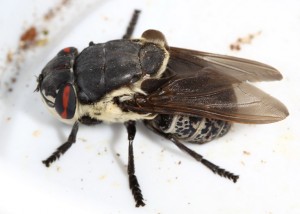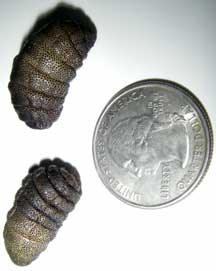Not for the Faint of Heart
— from B. Sadie Bailey —
I’ve written letters before about rabbits, and shared facts about their voracious and destructive habits. But I haven’t yet written about the health menace that rabbits carry and spread to other rodents and your pets: Botfly (Cuterebra).
You might see adult Botflies in early to mid-June. They are big and quite ugly; at first you might mistake a freshly metamorphosed adult for a horse fly. Adult bots have one sole purpose: to look for a mate and reproduce.
The female Botfly lays each egg singly, up to 2000 eggs in her 10-day lifetime as an adult! She can lay eggs in many locations, either directly onto a host, or in grass and vegetation around warrens or rodent burrows. Then an animal comes by and the eggs attach to the fur, i.e., the eggs could possibly end up inside your home with your pet. The tiny yellow eggs instantly hatch into larvae on a warm host — a rodent, your dog or cat — with a little moisture (such as wet fur, or licking). The larvae immediately burrow down, start eating the flesh of the host, and grow. They leave a small hole which enlarges as they grow, and often make hard lumps on the animal.
It is not safe to try to remove Cuterebra maggots yourself, due to the high rate of infection. If your pet has several, or many, larvae inside, the infestation can even kill your pet. If you see that your pet, including your pet rodent, has Botfly, call your Vet immediately. Another hazard of animals that carry bot are the costs you will incur with the vet, having the larvae removed. As the rabbit population grows, Botfly is becoming more prevalent.
Eastsound area is already infested with Botfly. My cat, a fabulous hunter, has come home several times with voles and mice full of mature larvae—the same size as in the picture. I’m terrified that one day, he will be infested with Botfly larvae, which can even burrow into an animal’s eye socket (think moisture).
For further information please read this article on fly-strike in rabbits. Scroll down to the part about Cuterebra.
**If you are reading theOrcasonian for free, thank your fellow islanders. If you would like to support theOrcasonian CLICK HERE to set your modestly-priced, voluntary subscription. Otherwise, no worries; we’re happy to share with you.**









